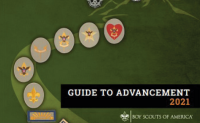In this article we’ll touch on the mechanics of meetings. Known as parliamentary procedure, it’s a set of rules by which business is conducted. Any large assembly, such as Parliament (where the name originates), Congress, or a corporate board meeting, follows a set process. A standard parliamentary procedure has been codified in Robert’s Rules of Order, first published by US Army General Henry Robert in the 1800s, revised many times since, and in nearly universal use in deliberative bodies around the world.
Fortunately, our troop committee meetings are usually informal and don’t need to follow a complex set of rules, but parliamentary procedure gives us the framework by which we can conduct official business when it’s necessary to do so.
Here are some suggestions as to how to follow a standard procedure when conducting committee meetings:
- A motion is the process by which business is defined, introduced, discussed and acted upon. 
- Be consistent on what requires a motion. Many items are made official simply by the lack of objection, such as the consent agenda or the treasurer’s report. In other cases, you may need to ask for a motion when the proposal is something specific. An example might be to move forward with a fundraiser, approve an Eagle service project, or purchase troop equipment.
- The person making the motion should state it exactly and make sure the secretary transcribes it correctly. Ask for a read-back after the motion is made and immediately prior to voting. Regardless of what is discussed, the language that appears in the minutes is what becomes official.
- The proper way to consider a topic is to ask for the motion once the topic of discussion has crystallized on something specific, and then confine the discussion to that which is covered by the motion.
- Remember that a motion requires a second from another member of the committee.
- Unless your troop or pack has decided otherwise, your direct leaders – the Scoutmaster, Cubmaster, Den Leaders and assistants – are not voting members of the committee, so they normally cannot make a motion or vote on it. Likewise, parents who are not registered as a Committee Member usually cannot vote (though their views should be heard as part of the discussion). At a Pack committee meeting, sometimes you only have the Cubmaster, some Den Leaders and the Committee Chair attend, so as a practical matter, you may customarily allow all present to cast a vote.
- Depending on your parliamentary rules, you can call the question (terminate discussion and ask for a vote) or a committee member can call the question, which normally requires a vote or assent by the committee. This is a good way to limit debate and contain the discussion to the time available. If more discussion is needed, it might be best to table the matter until you can allocate sufficient time, or to refer it to a subcommittee.
- Anything that changes the motion on the floor needs to be made in the form of an amendment. Amendments are discussed and voted on prior to voting on the main motion.
- Prior to voting on a motion or amendment, you should ask the secretary to read it back. Normally, a voice vote is sufficient. Rarely do you need to resort to a roll-call vote unless the group is sharply divided – and if it is, you probably have more work to do! Your goal should be to get to where most or all committee members are in agreement.
- If the motion fails, you may need to continue discussion and modify the original motion.
- Once the motion is acted upon, however – approved or tabled – move on to the next item.
As I’ve suggested before, be sure to take good notes during the meeting yourself, so you will know what was decided and to follow up with the people who need to put those decisions into action.
As the committee chair, your job is to drive the meeting, using the agenda as a road map and parliamentary procedure as traffic laws to get to the destination (adjournment) in a timely manner.
Next: The People Issues: Relationship Guidelines
Previous articles in this series:
- Effective committee meetings: Introduction
- Effective committee meetings: The purpose of meetings
- Planning committee meetings
- Agenda planning
- Time for the meeting!
This post first appeared on Bobwhite Blather.




